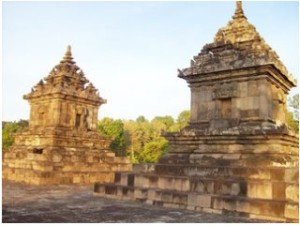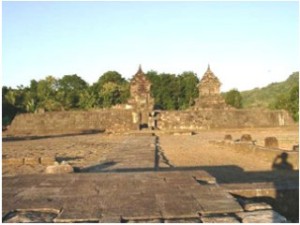 Barong Temple is located in the area Sambirejo, Prambanan. Hindu heritage temple is expected to be built around ke-9/10 century. Page Barong temple is divided into three parts, the higher the more backward. On the third terrace, the very top, is the most sacred pages. Barong Temple relic is a Hindu temple located in the hamlet Candisari, Bokoharjo, Prambanan.
Barong Temple is located in the area Sambirejo, Prambanan. Hindu heritage temple is expected to be built around ke-9/10 century. Page Barong temple is divided into three parts, the higher the more backward. On the third terrace, the very top, is the most sacred pages. Barong Temple relic is a Hindu temple located in the hamlet Candisari, Bokoharjo, Prambanan.Temple is called Barong because there are times in the recesses of the body ornaments of the temple that looks like Barong. The existence of Candi Barong also named Candi Sari Suragedug Baka Queen mentioned in the inscription (856 CE) in Sanskrit and written in ancient Javanese script. In these inscriptions is told about a king named Sri Sri Kalasodbhava Kumbaja or the construction of three ‘linga’, ie Krttiwasalingga with companion Dewi Sri, Goddess Suralaksmi Triyarbakalingga with companion, and Haralingga with companion Goddess Mahalaksmi.
It is estimated that the building in question is Candi Barong. In Pereng Inscription (863 AD), which is also written in Sanskrit using the ancient Javanese script, mentioned that in the year 784 Saka (860 M) Rakai Walaing Pu Kumbhayoni confer fields and two hills in Tamwahurang for maintenance purposes Shiva shrine called Bhadraloka. The experts argued that the Sri Kumbaja or Sri Kalasodbhava is Pu Kumbhayani and building in question is Shiva Temple Barong.
Unlike other temples in Central Java, Candi Barong is punden building terraces, namely model shrine during prahindu. This temple consists of three tiered terrace, getting onto the main small. Area of the first terrace is 90 x 63 m2, while the second terrace is 50 x 50 m2. Judging from the location of the ascent from terrace to terrace, this Hindu temple faces west. In the mid-west side there are stairs up from the first terrace to a second terrace at about 4 m with a width of 3 m.
The third terrace, which is 25 x 38 m2, situated 5 m from the surface of the second terrace, and can be reached via the staircase width 3.2 m. The stairs are equipped with a ladder on the left cheek-right hand. At the base of the stairs there are decorations like ‘ukel’ which has no clear shape. On the left and right walls of the stairs there is an ornament of his cheek kalpataru leaves are partially damaged. At the top of the stairs there is roofed gate (gate paduraksa) leading to the court of the third terrace. On the threshold of the gate there Kalamakara decoration.
 Terrace walls were given boosters in the form of the composition of andesite stone blocks which are refined with a layer of white stones on its surface. Temple terrace wall, from bottom to the top terrace, looks plain without decoration. Near the south end of west wall of the third terrace there is a niche that is not yet clear function.
Terrace walls were given boosters in the form of the composition of andesite stone blocks which are refined with a layer of white stones on its surface. Temple terrace wall, from bottom to the top terrace, looks plain without decoration. Near the south end of west wall of the third terrace there is a niche that is not yet clear function.In the court of the top terrace, which is regarded as the holiest place there are two buildings lining the north-south, each have a broad base of 8 x 8 m2. The first building is located at the south end, while the second is located in the center courtyard, directly opposite the stairs. At the northern end there are ruins of buildings that have not been restored.
The two existing buildings do not have to have the entrance to the temple body, because there is no room in it, although, according to the research, estimated that there are voids in body building. Niches that exist today were empty. Arca had placed there was no trace, although it is said at the time of its restoration goddess statues found 3 and 4 are characterized Syiwaistik god statue. On all four sides of each building there are only a niche where to put the statue. Above the threshold there are niches kalamakara decoration complete with mandibles very simple carvings.
there is no relief decoration on the wall and foot building, there are only patterned foliage and sculptures of human figures that simple. The roof of the temple compound with a pointed top. Seam roof and flower patterned kumuda.
No comments:
Post a Comment